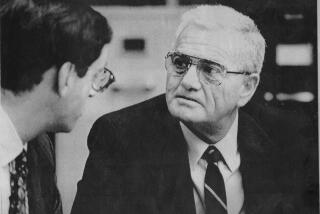Grand jury in Grim Sleeper case heard about gun, photo found at suspect’s house
- Share via
The gun that police concluded was used to shoot one woman and a photograph taken moments after a second woman had been shot were found at accused serial killer Lonnie Franklin Jr.’s South Los Angeles house, according to grand jury transcripts reviewed by The Times.
Those two pieces of incriminating evidence, previously not made public, appeared to further link Franklin to the 10 murders and one attempted murder he is accused of committing.
Franklin, 58, was arrested in July, culminating a three-year hunt by Los Angeles police to identify and capture the man accused of killing seven women between 1985 and 1988 and three others between 2002 and 2007. All of the victims were African American women living in South Los Angeles and most had been involved in drug use, police said. Either shot or strangled, the women’s bodies were dumped in alleyways and showed signs of sexual assault.
In March, prosecutors opted to fast-track Franklin’s legal proceedings by bypassing the typical preliminary hearing process in favor of a secretive grand jury. Over several days, dozens of witnesses were called to testify before the panel, which ultimately indicted Franklin and cleared the way for him to stand trial. The Times reviewed nearly 1,000 pages of transcripts of the evidence presented to the grand jury, which were recently made public.
Franklin, who has been denied bail, pleaded not guilty and remains in custody. His attorney, Louisa Pensanti, criticized the grand jury proceeding, saying she was not present to challenge any of the evidence.
“There’s an old adage,” she said, “that you can indict a ham sandwich at a grand jury.”
Aiming to lay out the wealth of evidence they claim to have collected against Franklin, prosecutors methodically called criminalists, forensic experts and police officers to testify before the grand jury. Much of the testimony focused on what prosecutors say is the combination of DNA and ballistic evidence tying Franklin to the crimes.
DNA experts told jurors repeatedly that Franklin’s genetic profile had been matched conclusively to the saliva, semen, blood and other genetic samples collected from eight of the victims’ bodies. Prosecutors paid special attention to the DNA sample taken from the plastic tie that was used to seal a garbage bag in which police discovered the body of one of the women. If Franklin’s attorney plans to argue during the trial that Franklin had sexual relations with the women but did not kill them, prosecutors will probably use the discovery of his DNA on the plastic tie to show otherwise.
And firearms experts testified that the same gun had been used to shoot eight of the women. A different gun was used to kill 25-year-old Janecia Peters, Franklin’s last alleged victim.
After police removed nine handguns from Franklin’s house, Deputy Dist. Atty. Beth Silverman told jurors that authorities “were astonished to learn” through ballistics tests that one of the weapons — a blue steel Titan semi-automatic — was the gun used to shoot Peters in the back. The gun used to shoot the other women was not recovered.
Silverman also revealed that on the floor of a garage at the back of Franklin’s property police discovered a photograph of Enietria Washington, the woman who survived a 1988 attack by a man prosecutors say was Franklin.
Washington told the grand jury that a man had driven up alongside her as she walked along Normandie Avenue and convinced her to let him give her a ride to her friend’s house. Washington testified that the man shot her as she sat in the passenger seat of the car, sexually assaulted her and took at least one Polaroid photograph of her as she fell in and out of consciousness.
The Polaroid photograph found at Franklin’s house shows Washington bleeding in the front seat of a car with her blouse ripped open.
The apparent period of inactivity between the two sets of killings earned Franklin the moniker the Grim Sleeper, from the L.A. Weekly newspaper. Throughout the investigation, however, police had been openly skeptical of the idea that the slayings stopped during the 13-year gap, and last month investigators announced their suspicions that eight other missing women may have been his victims.
More to Read
Sign up for Essential California
The most important California stories and recommendations in your inbox every morning.
You may occasionally receive promotional content from the Los Angeles Times.











